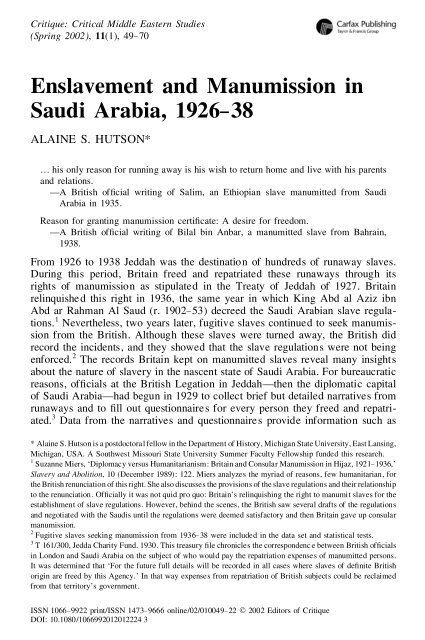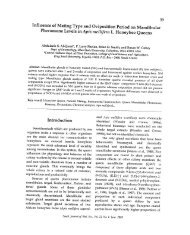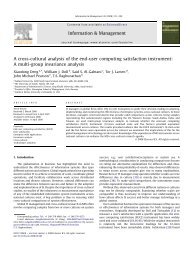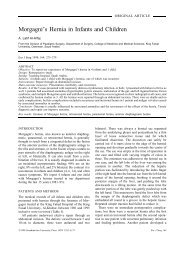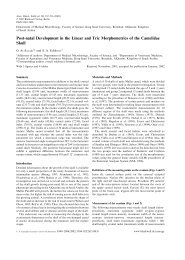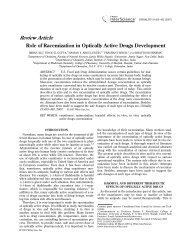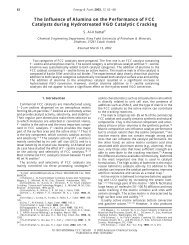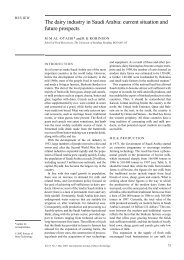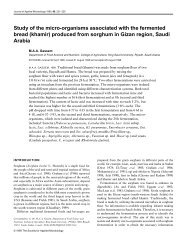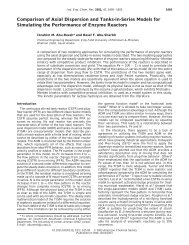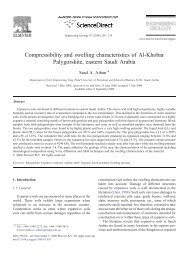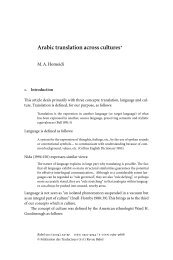Enslavement and Manumission in Saudi Arabia, 1926-38
Enslavement and Manumission in Saudi Arabia, 1926-38
Enslavement and Manumission in Saudi Arabia, 1926-38
Create successful ePaper yourself
Turn your PDF publications into a flip-book with our unique Google optimized e-Paper software.
Critique: Critical Middle Eastern Studies<br />
(Spr<strong>in</strong>g 2002), 11(1), 49–70<br />
<strong>Enslavement</strong> <strong>and</strong> <strong>Manumission</strong> <strong>in</strong><br />
<strong>Saudi</strong> <strong>Arabia</strong>, <strong>1926</strong>–<strong>38</strong><br />
ALAINE S. HUTSON*<br />
… his only reason for runn<strong>in</strong>g away is his wish to return home <strong>and</strong> live with his parents<br />
<strong>and</strong> relations.<br />
—A British of cial writ<strong>in</strong>g of Salim, an Ethiopian slave manumitted from <strong>Saudi</strong><br />
<strong>Arabia</strong> <strong>in</strong> 1935.<br />
Reason for grant<strong>in</strong>g manumission certi cate: A desire for freedom.<br />
—A British of cial writ<strong>in</strong>g of Bilal b<strong>in</strong> Anbar, a manumitted slave from Bahra<strong>in</strong>,<br />
19<strong>38</strong>.<br />
From <strong>1926</strong> to 19<strong>38</strong> Jeddah was the dest<strong>in</strong>ation of hundreds of runaway slaves.<br />
Dur<strong>in</strong>g this period, Brita<strong>in</strong> freed <strong>and</strong> repatriated these runaways through its<br />
rights of manumission as stipulated <strong>in</strong> the Treaty of Jeddah of 1927. Brita<strong>in</strong><br />
rel<strong>in</strong>quished this right <strong>in</strong> 1936, the same year <strong>in</strong> which K<strong>in</strong>g Abd al Aziz ibn<br />
Abd ar Rahman Al Saud (r. 1902–53) decreed the <strong>Saudi</strong> <strong>Arabia</strong>n slave regulations.<br />
1 Nevertheless, two years later, fugitive slaves cont<strong>in</strong>ued to seek manumission<br />
from the British. Although these slaves were turned away, the British did<br />
record the <strong>in</strong>cidents, <strong>and</strong> they showed that the slave regulations were not be<strong>in</strong>g<br />
enforced. 2 The records Brita<strong>in</strong> kept on manumitted slaves reveal many <strong>in</strong>sights<br />
about the nature of slavery <strong>in</strong> the nascent state of <strong>Saudi</strong> <strong>Arabia</strong>. For bureaucratic<br />
reasons, of cials at the British Legation <strong>in</strong> Jeddah—then the diplomatic capital<br />
of <strong>Saudi</strong> <strong>Arabia</strong>—had begun <strong>in</strong> 1929 to collect brief but detailed narratives from<br />
runaways <strong>and</strong> to ll out questionnaires for every person they freed <strong>and</strong> repatriated.<br />
3 Data from the narratives <strong>and</strong> questionnaires provide <strong>in</strong>formation such as<br />
* Ala<strong>in</strong>e S. Hutson is a postdoctoral fellow <strong>in</strong> the Department of History, Michigan State University, East Lans<strong>in</strong>g,<br />
Michigan, USA. A Southwest Missouri State University Summer Faculty Fellowship funded this research.<br />
1 Suzanne Miers, ‘Diplomacy versus Humanitarianism: Brita<strong>in</strong> <strong>and</strong> Consular <strong>Manumission</strong> <strong>in</strong> Hijaz, 1921–1936,’<br />
Slavery <strong>and</strong> Abolition, 10 (December 1989): 122. Miers analyzes the myriad of reasons, few humanitarian, for<br />
the British renunciation of this right. She also discusses the provisions of the slave regulations <strong>and</strong> their relationship<br />
to the renunciation. Of cially it was not quid pro quo: Brita<strong>in</strong>’s rel<strong>in</strong>quish<strong>in</strong>g the right to manumit slaves for the<br />
establishment of slave regulations. However, beh<strong>in</strong>d the scenes, the British saw several drafts of the regulations<br />
<strong>and</strong> negotiated with the <strong>Saudi</strong>s until the regulations were deemed satisfactory <strong>and</strong> then Brita<strong>in</strong> gave up consular<br />
manumission.<br />
2 Fugitive slaves seek<strong>in</strong>g manumission from 1936–<strong>38</strong> were <strong>in</strong>cluded <strong>in</strong> the data set <strong>and</strong> statistical tests.<br />
3 T 161/300, Jedda Charity Fund. 1930. This treasury le chronicles the correspondenc e between British of cials<br />
<strong>in</strong> London <strong>and</strong> <strong>Saudi</strong> <strong>Arabia</strong> on the subject of who would pay the repatriation expenses of manumitted persons.<br />
It was determ<strong>in</strong>ed that ‘For the future full details will be recorded <strong>in</strong> all cases where slaves of de nite British<br />
orig<strong>in</strong> are freed by this Agency.’ In that way expenses from repatriation of British subjects could be reclaimed<br />
from that territory’s government.<br />
ISSN 1066–9922 pr<strong>in</strong>t/ISSN 1473–9666 onl<strong>in</strong>e/02/010049–22 Ó 2002 Editors of Critique<br />
DOI: 10.1080/1066992012012224 3
ALAINE S. HUTSON<br />
who was enslaved, how the enslavement came about, from where slaves<br />
orig<strong>in</strong>ated, how long persons were enslaved, the k<strong>in</strong>d of work performed by<br />
slaves, <strong>and</strong> the family lives of slaves. All together the Foreign Of ce les give<br />
<strong>in</strong>formation on 262 people. 4 The les do not describe all slavery variables for<br />
each <strong>in</strong>dividual. However, for at least 84 percent of former slaves the gender,<br />
country of orig<strong>in</strong>, occupation while enslaved, age at manumission, <strong>and</strong> method<br />
of enslavement is recorded; <strong>and</strong> the number of masters <strong>and</strong> number of years<br />
enslaved is established for 54 percent.<br />
The rich <strong>in</strong>formation from these les provides answers to questions that<br />
scholars deem crucial for underst<strong>and</strong><strong>in</strong>g slavery <strong>in</strong> Muslim l<strong>and</strong>s. For example,<br />
John Hunwick has raised questions that need answers: ‘What was the ratio of<br />
men to women freed; how many were released <strong>in</strong> their prime as opposed to old<br />
age; … how many years did men or women serve <strong>in</strong> slavery; … what k<strong>in</strong>ds of<br />
occupations did slaves undertake <strong>and</strong> what skills may they have acquired that<br />
prepared them for ensur<strong>in</strong>g viability as free persons?’ 5 Details from these<br />
narratives were subjected to statistical analyses to derive answers about freed<br />
slaves from <strong>Saudi</strong> <strong>Arabia</strong>. 6 Shaun Marmon br<strong>in</strong>gs up an issue that can be<br />
<strong>in</strong>vestigated as a result of these data. That is, whether ‘slavery as constructed by<br />
Islamic law <strong>and</strong> slavery as practiced by Muslim communities seem to co<strong>in</strong>cide<br />
with remarkable symmetry’ or whether <strong>in</strong>dividual slave owners <strong>in</strong> early twentieth<br />
century <strong>Saudi</strong> <strong>Arabia</strong> ‘blatantly violated’ the pr<strong>in</strong>ciples of benevolence <strong>in</strong> the<br />
shariah. 7<br />
4 I have <strong>in</strong>dividual documents (narratives <strong>and</strong>/or questionnaires) for 59 former slaves. Data for the others are<br />
summarized <strong>in</strong> a 1934 report: F.O. 905/11, Slaves: General Question (206 are listed <strong>in</strong> the report, 6 of whom have<br />
<strong>in</strong>dividual documents); <strong>and</strong> <strong>in</strong> updated reports of manumissions from 1930 to 1935: F.O. 905/28, Slaves:<br />
<strong>Manumission</strong>: Individual Cases. 1935 (53 slaves are listed <strong>in</strong> the updates, 50 of whom have <strong>in</strong>dividual documents).<br />
5 John O. Hunwick, ‘The Same but Different: Approaches to Slavery <strong>and</strong> the African Diaspora <strong>in</strong> the L<strong>and</strong>s of<br />
Islam,’ paper presented at the Workshop on Slavery <strong>and</strong> the African Diaspora <strong>in</strong> the L<strong>and</strong>s of Islam, 30 April–2<br />
May 1999, Northwestern University, pp. 3–5.<br />
6 Information from the narratives <strong>and</strong> questionnaires for each fugitive slave was organized <strong>in</strong>to a table. Table<br />
columns were set up for each variable—<strong>in</strong>clud<strong>in</strong>g name, gender, the country of orig<strong>in</strong>, occupation, age at the time<br />
of manumission, method of enslavement, number of masters, number of years enslaved, reasons for runn<strong>in</strong>g away,<br />
etc. All the raw data columns were analyzed to determ<strong>in</strong>e the number <strong>and</strong> percentage of each category with<strong>in</strong><br />
the variable (e.g., washerwoman, bodyguard , etc. with<strong>in</strong> the occupation variable). Some of the variables, such<br />
as age, were cont<strong>in</strong>uous <strong>and</strong> numeric <strong>and</strong> did not need recod<strong>in</strong>g <strong>in</strong> order to perform further tests. Other variables<br />
such as occupation were nom<strong>in</strong>al with six or more categories. Those variables were recoded <strong>in</strong>to columns,<br />
typically, with two to four categories. Chi-square tests were then performed on nearly all comb<strong>in</strong>ations of nom<strong>in</strong>al,<br />
recoded variables. Chi-square is a nonparametric statistical test that compares actual to expected quantities of<br />
categorical data. Expected values are calculated for a given cell through the product of the marg<strong>in</strong>al probabilities<br />
of the two categories de n<strong>in</strong>g the cell. For example, if women were 25 percent of a test of gender <strong>and</strong> occupation<br />
statistically, one would expect 25 percent of each occupation to be female. If there was a signi cant percentage<br />
more or less of women <strong>in</strong> an occupation, that would suggest strongly that gender affected who entered that trade.<br />
Chi-square probabilities of .05 or less were considered signi cant. However, probabilities less than .07 were also<br />
reported.One cont<strong>in</strong>uous variable, years enslaved, was recoded as ‘20 years or less’ <strong>and</strong> ‘more than 20 years.’<br />
Years enslaved was tested both as a cont<strong>in</strong>uous variable (through a median test) <strong>and</strong> a nom<strong>in</strong>al, recoded variable<br />
(chi-square test). Pairs of nom<strong>in</strong>al <strong>and</strong> cont<strong>in</strong>uous variables were tested to determ<strong>in</strong>e mean, median, maximum,<br />
<strong>and</strong> m<strong>in</strong>imum for each nom<strong>in</strong>al category.<br />
7 Shaun Marmon, ed., Slavery <strong>in</strong> the Islamic Middle East (Pr<strong>in</strong>ceton, NJ: Markus We<strong>in</strong>er, 1999), p. vii.<br />
50
Description of the Data<br />
ENSLAVEMENT AND MANUMISSION IN SAUDI ARABIA<br />
A major question about the data <strong>and</strong> nd<strong>in</strong>gs of this research will be: are they<br />
peculiar to <strong>Saudi</strong> <strong>Arabia</strong> or could they possibly po<strong>in</strong>t to general trends with<br />
respect to twentieth-century slavery <strong>in</strong> the <strong>Arabia</strong>n Pen<strong>in</strong>sula? In order to beg<strong>in</strong><br />
answer<strong>in</strong>g this question, the data will be compared with data collected by British<br />
of cials <strong>in</strong> Bahra<strong>in</strong>, where possible. The British Agency <strong>in</strong> Bahra<strong>in</strong> manumitted<br />
runaway slaves from 1917 to 1965. From <strong>1926</strong> to 1936, the of cials recorded<br />
<strong>in</strong>formation for 190 freed people, <strong>in</strong>clud<strong>in</strong>g the fugitives’ age, gender, <strong>and</strong><br />
reason for receiv<strong>in</strong>g a manumission certi cate. 8 Because these statistics from<br />
Bahra<strong>in</strong> recorded similar data to those from <strong>Saudi</strong> <strong>Arabia</strong>, the two sets will be<br />
compared to see whether the conditions of slavery also were similar.<br />
Because the British recorded the narratives <strong>and</strong> held an of cial anti-slavery<br />
position, questions about the data’s reliability are <strong>in</strong>evitable <strong>and</strong> proper. Suzanne<br />
Miers had such doubts when she used some of the same British documents <strong>in</strong><br />
her 1989 article <strong>in</strong> Slavery <strong>and</strong> Abolition. Miers believed that, despite the<br />
rst-h<strong>and</strong> narratives of fugitive slaves, the documents only re ected British<br />
perceptions of slavery <strong>in</strong> <strong>Arabia</strong>. 9 I share some of her caution about the<br />
limitations of the data. However, I believe fugitive slaves’ accounts were not<br />
merely re ections of British policy. The British method of collect<strong>in</strong>g <strong>and</strong><br />
check<strong>in</strong>g the data, their restra<strong>in</strong>t <strong>in</strong> terms of assign<strong>in</strong>g motives or offer<strong>in</strong>g<br />
<strong>in</strong>terpretations, their ambivalence about the subject, <strong>and</strong> the diversity found <strong>in</strong><br />
the documents, all <strong>in</strong>dicate that the British did not attempt to skew the narratives<br />
to show <strong>Saudi</strong> <strong>Arabia</strong>n slavery <strong>in</strong> either a negative or positive light.<br />
The British of cers rarely assigned motives to the slave’s or master’s actions.<br />
The primary focus <strong>and</strong> purpose of their questionnaire was to determ<strong>in</strong>e how <strong>and</strong><br />
where slaves were captured, sold, <strong>and</strong> resold; the British spent little time<br />
document<strong>in</strong>g the why of escape, capture, or sale. Also the British were not<br />
accept<strong>in</strong>g of, or sympathetic to, all the fugitives had to say. The of cers<br />
<strong>in</strong>vestigated refugees’ stories for many reasons. Two reasons were primary: the<br />
British did not wish to <strong>in</strong>cense the <strong>Saudi</strong> government by encourag<strong>in</strong>g or seek<strong>in</strong>g<br />
slaves to manumit; nor did they want to pay for the repatriation of people who<br />
were not slaves. In addition, some people apply<strong>in</strong>g for manumission were<br />
discovered to be free persons either seek<strong>in</strong>g free passage back home or refuge<br />
from oppressive relatives <strong>and</strong> were turned away from the legation. 10<br />
The ambivalence of the British to their role <strong>in</strong> manumission is alluded to by<br />
their marg<strong>in</strong>al comments throughout the documents <strong>and</strong> evidenced by their<br />
8 F.O. 1016/464, Bahra<strong>in</strong>: Agency, <strong>Manumission</strong> Register. 1919–1965. Other <strong>in</strong>formation is recorded but without<br />
more documents it is impossible to underst<strong>and</strong> its signi cance. For <strong>in</strong>stance, some runaways are designated as<br />
‘Bahra<strong>in</strong>’ or ‘Trucial states slave’ (Trucial States was the name for the British dependenc y that became the United<br />
Arab Emirates <strong>in</strong> 1971). This designation could mean they were born <strong>in</strong> those areas to slave parents or born free<br />
subjects of those areas. From where the rest of the slaves came is not recorded; without reports or accompany<strong>in</strong>g<br />
papers it is impossible to determ<strong>in</strong>e their orig<strong>in</strong>s.<br />
9 Miers, ‘Diplomacy versus Humanitarianism: Brita<strong>in</strong> <strong>and</strong> Consular <strong>Manumission</strong> <strong>in</strong> Hijaz, 1921–1936,’ p. 103.<br />
10 C.O. 732/62/8, Slavery <strong>in</strong> the Middle East. 1933; <strong>and</strong> F.O. 905/28, 3 September 1935.<br />
51
ALAINE S. HUTSON<br />
renunciation of that role <strong>in</strong> 1936. Two examples from the marg<strong>in</strong>s demonstrate<br />
this ambivalence. One British of cial noted <strong>in</strong> the case of Nasra that her local<br />
manumission would be ‘most satisfactory for the girl (& our pockets) as she is<br />
not at all keen on go<strong>in</strong>g abroad.’ 11 When Feyruz, a fugitive slave from an<br />
aristocratic household, told a British of cer that there were 30 more slaves <strong>in</strong> his<br />
master’s household who wished to be manumitted, one of cial responded ‘O<br />
Lord!’ 12<br />
The brief report summaries <strong>and</strong> nal, typed questionnaires have a formulaic<br />
pattern to them. However, the of cers’ <strong>in</strong>terview notes give more details <strong>and</strong> are<br />
less formulaic, us<strong>in</strong>g a pattern usually only for record<strong>in</strong>g name, demographic<br />
<strong>in</strong>formation, <strong>and</strong> an end<strong>in</strong>g that registered their arrival at the legation. The tenor<br />
<strong>and</strong> diversity of the documents suggest that British ambivalence acted as a<br />
control; I believe it limited British distortion of slaves’ rst-h<strong>and</strong> narratives. In<br />
contrast, n<strong>in</strong>eteenth- <strong>and</strong> twentieth-century European travelers’ <strong>in</strong>terpretations<br />
<strong>and</strong> the op<strong>in</strong>ions of Arab slave owners <strong>and</strong> jurists, on which the current<br />
scholarship of Middle Eastern slavery is based, have de nite biases. Although<br />
Islamic law designates slaves as ‘property with voice,’ 13 their voices are largely<br />
miss<strong>in</strong>g from most scholarly <strong>in</strong>terpretations of the Middle Eastern <strong>in</strong>stitution.<br />
But the narratives of freed men <strong>and</strong> women are from the other side of the power<br />
divide. Thus, these <strong>in</strong>terviews give the enslaved a role <strong>in</strong> shap<strong>in</strong>g our knowledge<br />
of twentieth-century slavery <strong>in</strong> <strong>Saudi</strong> <strong>Arabia</strong>.<br />
Obviously the statistical data <strong>in</strong> this article do not come from a r<strong>and</strong>om<br />
sample. On the contrary, the subjects were self-selected <strong>and</strong> disgruntled with<br />
<strong>Saudi</strong> slavery. Therefore, the data may not be representative of the entire<br />
enslaved population <strong>in</strong> <strong>Saudi</strong> <strong>Arabia</strong>. 14 However, much of what has been written<br />
on slavery <strong>in</strong> the Middle East has been based on the mythical mus<strong>in</strong>gs of free<br />
European orientalists <strong>and</strong> travelers. Bernard Lewis began debunk<strong>in</strong>g these<br />
myths, but the <strong>in</strong>adequacies of n<strong>in</strong>eteenth-centur y writ<strong>in</strong>gs on the subject go<br />
much deeper than he revealed. 15 Lewis suggested that although the method of<br />
enslavement, transportation, <strong>and</strong> sale of slaves were more than likely the same<br />
<strong>in</strong> Atlantic, Saharan, <strong>and</strong> Indian Ocean trad<strong>in</strong>g, ‘[i]t was <strong>in</strong> the treatment<br />
accorded to the slaves by their new masters, <strong>and</strong> the place assigned to them <strong>in</strong><br />
the societies to which they had come, that the ma<strong>in</strong> contrast was to be seen.’ 16<br />
Even that contrast is yet to be proven by historians, for it cannot rest solely on<br />
European observations of the n<strong>in</strong>eteenth or twentieth centuries. The data provided<br />
by runaway African slaves demonstrate the need to revise the historiography<br />
of slavery <strong>in</strong> <strong>Saudi</strong> <strong>Arabia</strong> <strong>and</strong> perhaps the Middle East.<br />
Although the data from the British les are rich <strong>in</strong> many ways, they also have<br />
11<br />
F.O. 905/28, 12 February 1934.<br />
12<br />
F.O. 905/28, 15 May 1935.<br />
13<br />
Yvonne Seng, ‘A Lim<strong>in</strong>al State: Slavery <strong>in</strong> Sixteenth-century Istanbul,’ <strong>in</strong> Marmon, ed., Slavery <strong>in</strong> the Islamic<br />
Middle East, p. 25.<br />
14<br />
The same holds true for Bahra<strong>in</strong>.<br />
15<br />
Bernard Lewis, Race <strong>and</strong> Slavery <strong>in</strong> the Middle East (New York: Oxford University Press, 1990), pp. 99–102.<br />
16 Ibid., p. 100.<br />
52
ENSLAVEMENT AND MANUMISSION IN SAUDI ARABIA<br />
Table 1. Total number of runaway slaves by gender<br />
<strong>Saudi</strong> <strong>Arabia</strong> (n 5 262) Bahra<strong>in</strong> (n 5 190)<br />
Women Men Women Men<br />
Number 72 190 29 161<br />
% of country survey 27.5 72.5 15 85<br />
some limitations. The size of the statistical samples for each slavery variable<br />
differs. As aforementioned, <strong>in</strong>dividual les do not record statistics for each<br />
aspect of slavery for each slave. The les were kept <strong>in</strong> such a manner that one<br />
cannot determ<strong>in</strong>e whether each <strong>in</strong>dividual was asked about all of the issues or<br />
whether some issues were recorded only if a runaway brought them up. For<br />
example, 90 <strong>in</strong>dividuals <strong>in</strong> the entire survey (n 5 262) <strong>in</strong>dicate their reasons for<br />
runn<strong>in</strong>g away from their masters. However, there was no speci c space on the<br />
questionnaire <strong>in</strong> which to record a reason for runn<strong>in</strong>g away. 17 Therefore, the n<br />
values for the statistics quoted, tables, <strong>and</strong> chi-square tests presented throughout<br />
this paper denote the number of freed men <strong>and</strong> women for whom there are data<br />
on those particular variables or comb<strong>in</strong>ation of variables. The data can test<br />
empirically for answers to crucial questions concern<strong>in</strong>g the history of slavery <strong>in</strong><br />
twentieth-century <strong>Saudi</strong> <strong>Arabia</strong>.<br />
Ratio of Men to Women Freed<br />
Most scholarship on slavery <strong>in</strong>dicates that more African women than men were<br />
sold <strong>in</strong>to the trans-Saharan <strong>and</strong> other slave trades bound for the Arab Muslim<br />
world. 18 Yet, <strong>in</strong> the <strong>Saudi</strong> <strong>Arabia</strong>n statistics, men outnumbered women 2.64 to<br />
1. Women accounted for 27.5 percent of those who sought refuge at the British<br />
Legation (n 5 72), whereas men were 72.5 percent (n 5 190). While women<br />
appear to be underrepresented, the number of women who ran away is a<br />
signi cant one <strong>and</strong> gives a female perspective on slavery (see Table 1). The<br />
number of women runn<strong>in</strong>g away from <strong>Saudi</strong> slavery appears more signi cant<br />
when compared with the Bahra<strong>in</strong>i statistics. The ratio of male to female refugee<br />
slaves <strong>in</strong> Bahra<strong>in</strong> was 5.55 to 1. Women were only 15 percent of those seek<strong>in</strong>g<br />
freedom (n 5 29) compared to 85 percent for men (n 5 161).<br />
The variation <strong>in</strong> the gender ratio between these two countries <strong>in</strong>dicates that<br />
throughout the Middle East the ratio of men to women who ga<strong>in</strong>ed freedom<br />
through escape varied. The variation may po<strong>in</strong>t to a difference <strong>in</strong> access to<br />
British diplomatic sites. But it is also plausible that it re ects differences <strong>in</strong> the<br />
17 See the Appendix for photocopies of questionnaires from the Public Record Of ce.<br />
18 Ralph Austen, ‘The Trans-Saharan Slave Trade: A Tentative Census,’ <strong>in</strong> Henry A. Gemery <strong>and</strong> Jan S.<br />
Hogendorn, eds., The Uncommon Market: Essays <strong>in</strong> the Economic History of the Atlantic Slave Trade (New York:<br />
Academic Press, 1979), p. 44; <strong>and</strong> Claire Robertson <strong>and</strong> Mart<strong>in</strong> Kle<strong>in</strong>, Women <strong>and</strong> Slavery <strong>in</strong> Africa (Madison:<br />
University of Wiscons<strong>in</strong> Press, 1983), p. 4.<br />
53
ALAINE S. HUTSON<br />
treatment accorded to enslaved women, the type of labor women performed,<br />
rates of fecundity among women (<strong>and</strong> therefore opportunities for manumission<br />
by bear<strong>in</strong>g children of masters), <strong>and</strong> rates of marriage to masters or slaves <strong>in</strong><br />
each region. These variables all affected the options open to women upon<br />
manumission <strong>and</strong> may have played a large factor <strong>in</strong> whether women chose to run<br />
away <strong>and</strong> eventually to be manumitted from slavery. In <strong>Saudi</strong> <strong>Arabia</strong>, women<br />
had the option of be<strong>in</strong>g manumitted <strong>and</strong> repatriated to their homel<strong>and</strong>, with the<br />
possibility of nd<strong>in</strong>g relatives, or be<strong>in</strong>g manumitted locally. 19<br />
Women’s narratives illustrate the effect these variables had on their decisions.<br />
Marriage <strong>and</strong> family could determ<strong>in</strong>e a woman’s actions. 20 One woman went to<br />
the legation seek<strong>in</strong>g manumission; her master agreed to manumit her <strong>and</strong> then<br />
married her. 21 Halima b<strong>in</strong>t Mabruk Okkash, a woman enslaved <strong>in</strong> Jeddah, ran<br />
away with her young daughter, Zahra, <strong>and</strong> requested local manumission. At rst<br />
she hid the fact that her master was Zahra’s father <strong>and</strong> claimed the child<br />
belonged to another slave; this claim was no doubt an attempt to keep her <strong>in</strong>fant<br />
girl. 22 Halima’s master agreed to manumit her <strong>and</strong> acknowledge the child as his<br />
own; therefore, we must assume that Zahra lived as a free person. Hav<strong>in</strong>g<br />
secured free status for her daughter <strong>and</strong> herself, Halima returned to her master’s<br />
house, the only option she had to reta<strong>in</strong> contact with her child. 23<br />
Jamila b<strong>in</strong>t Abdullah ran away with her husb<strong>and</strong> Salem, a Sudanese slave<br />
soldier, because their family life was threatened; their owner had threatened to<br />
sell Salem unless he divorced her. 24 Jamila had already lost one family due to<br />
her enslavement. She was married <strong>and</strong> had a daughter when she was captured <strong>in</strong><br />
Sudan <strong>and</strong> sold <strong>in</strong>to slavery. 25 Her previous marriage was nulli ed. 26 Instead of<br />
allow<strong>in</strong>g her second marriage to be torn apart by sale, Jamila <strong>and</strong> Salem ran<br />
away, were manumitted, <strong>and</strong> repatriated to Sudan together. Jamila speci cally<br />
expressed her desire to nd her daughter when she returned to Sudan.<br />
19<br />
Two women chose to leave the legation without manumission; presumably they returned to their masters.<br />
20<br />
Thirty-two women <strong>in</strong>dicated the reason they ran away. Of those, 10 women (31.25 percent) cited family reasons;<br />
of the 10, six females, four from one family, chose manumission <strong>and</strong> repatriation. One was manumitted locally,<br />
but the fate of the other three women, one of whom had a child, is unknown.<br />
21<br />
F.O. 905/11; In F.O. 905/27, Slaves: <strong>Manumission</strong>: General Question. 1935, a British of cial reports that 23<br />
other people were manumitted by their owners at the legation from 1929 to 1934 <strong>and</strong> cont<strong>in</strong>ued to live <strong>in</strong> <strong>Saudi</strong><br />
<strong>Arabia</strong>. Because they never expected to return to the African cont<strong>in</strong>ent, no records were kept detail<strong>in</strong>g their history<br />
or gender <strong>and</strong> they are not <strong>in</strong>cluded <strong>in</strong> the data.<br />
22<br />
Accord<strong>in</strong>g to I. P. Petrushevsky, Islam <strong>in</strong> Iran, trans. Hubert Evans (London: Athlone Press, 1985), pp. 156–57,<br />
Islamic codes of law only allowed slave women to keep their children with them until the age of seven, at the<br />
latest. Women who bore their master’s children could not be sold or given away, but Islamic law only m<strong>and</strong>ated<br />
their manumission upon the death of their masters <strong>and</strong> only if one of their children was still alive.<br />
23<br />
F.O. 905/28, 9 April 1935.<br />
24<br />
Jamila’s story is an example of a Muslim master exercis<strong>in</strong>g the right to force a slave to divorce his wife;<br />
Petrushevsky, Islam <strong>in</strong> Iran, p. 156, reports this right.<br />
25<br />
F.O. 905/28, 9 April 1935.<br />
26<br />
Both Petrushevsky, Islam <strong>in</strong> Iran, p. 156, <strong>and</strong> Imam Muslim, Al-Jami’ al-sahih, trans. Abdul Hamid Siddiqi<br />
(Lahore: Muhammad Ashraf, 1973), p. 743, discuss the nulli cation of a slave woman’s marriage <strong>in</strong> the context<br />
of be<strong>in</strong>g captured as a prisoner of war. Despite the fact that Jamila <strong>and</strong> other slaves were not pagan prisoners of<br />
war, their orig<strong>in</strong>al families were discarded <strong>in</strong> the same way <strong>and</strong> perhaps justi ed by hadith.<br />
54
ENSLAVEMENT AND MANUMISSION IN SAUDI ARABIA<br />
In another <strong>in</strong>stance, three generations of slave women <strong>and</strong> girls ran away<br />
together, look<strong>in</strong>g to be repatriated. The eldest woman of this family was named<br />
Bakhita. She knew well the tensions <strong>in</strong> slave society that could divide families;<br />
Bakhita’s husb<strong>and</strong> had run away four years earlier <strong>and</strong> her daughter Kelyba’s<br />
husb<strong>and</strong> had just been taken to another city to be sold. Upon her son-<strong>in</strong>-law’s<br />
removal from the house, Bakhita took the chance to run away <strong>in</strong> order to save<br />
what was left of her family: her daughter, Kelyba, <strong>and</strong> her two gr<strong>and</strong>daughters,<br />
Aysha <strong>and</strong> Bureyka. 27 Jamila’s <strong>and</strong> Bakhita’s stories <strong>in</strong>dicate that those enslaved<br />
attempted to hold their families together while enslaved, to nd their free<br />
families <strong>in</strong> their own l<strong>and</strong>s, <strong>and</strong> would take bold moves to keep their families<br />
<strong>in</strong>tact.<br />
A few women also seem to have used ight as a strategy to secure a better<br />
status with<strong>in</strong> their master’s families for themselves <strong>and</strong> their children. Halima’s<br />
story resulted <strong>in</strong> of cial recognition of her daughter’s father <strong>and</strong> therefore<br />
Zahra’s free status. In addition to Halima, another woman ran away because she<br />
had hoped to be freed after bear<strong>in</strong>g her master a child. That woman’s fate is not<br />
<strong>in</strong>dicated <strong>in</strong> the record, but her mention of this issue suggests that she was<br />
concerned about the effect of childbear<strong>in</strong>g on women’s freedom. 28<br />
Slave men <strong>in</strong> the sample also expressed a desire for family <strong>in</strong> their narratives.<br />
Salim was an Ethiopian bodyguard who served Amir Muhammad Abd ar<br />
Rahman, a brother of K<strong>in</strong>g Abd al Aziz. Salim accompanied the amir from<br />
Riyadh to Mecca dur<strong>in</strong>g the pilgrimage of 1935. His proximity to Jeddah gave<br />
him an opportunity to escape. In his <strong>in</strong>terview with British of cials, Salim<br />
clearly stated that as a soldier <strong>and</strong> a bodyguard he had been ‘well-treated.’<br />
Regardless of his conditions while a slave, Salim wanted to ‘return home <strong>and</strong><br />
live with his parents.’ 29 Although he had been captured as a preteen <strong>and</strong> enslaved<br />
for most of his young life, Salim remembered his father clearly. He knew his<br />
father’s name <strong>and</strong> occupation, the name of the quarter <strong>in</strong> Addis Ababa <strong>in</strong> which<br />
he lived, <strong>and</strong> the name of the of cial <strong>in</strong> charge of that section of the city. Salim<br />
took a dangerous chance <strong>in</strong> order to rega<strong>in</strong> his family.<br />
Although men did escape from <strong>Saudi</strong> <strong>Arabia</strong> with their families or to rejo<strong>in</strong><br />
their families, a further exploration of the gender statistics shows that slave<br />
women were more likely than slave men to run away because their families were<br />
threatened <strong>in</strong> some way. A chi-square test of whether gender affected a slave’s<br />
reasons for runn<strong>in</strong>g away proved signi cant. 30 The test showed that women were<br />
2.7 times more likely than men to run away for family reasons; 31.25 percent<br />
of women who ran away did so because of family or with family members,<br />
whereas only 11.5 percent of men who gave a reason ran away because of family<br />
concerns. That is, although women comprised only 27.5 percent of the total<br />
27<br />
F.O. 904/28, 14 October 1935.<br />
28<br />
F.O. 905/11.<br />
29<br />
F.O. 905/28, 15 April 1935.<br />
30 2<br />
(n 5 93, v 5 9.37, df 5 3, p , .03).<br />
55
ALAINE S. HUTSON<br />
survey, they represented 59 percent of those who stated they had run away for<br />
family reasons.<br />
Slaves Released <strong>in</strong> the Prime of Life<br />
The statistics from <strong>Saudi</strong> <strong>Arabia</strong> <strong>and</strong> Bahra<strong>in</strong> revealed that <strong>in</strong> an overwhelm<strong>in</strong>g<br />
percentage of cases, slaves ran away <strong>in</strong> their prime. In this study, the de nition<br />
of ‘prime’ was between the ages of 15 <strong>and</strong> 45. For <strong>Saudi</strong> <strong>Arabia</strong>, 240 slaves<br />
reported their age. Of this number, 80 percent (n 5 195) were between 15 <strong>and</strong><br />
45 years of age. The mean age of freed men <strong>and</strong> freed women was 30.7, <strong>and</strong> the<br />
median was 30. The statistics for 188 runaways <strong>in</strong> Bahra<strong>in</strong> were similar; the<br />
percentage <strong>in</strong> their prime was higher, at 89 percent (n 5 167), but their mean age<br />
was 30, as was their median age.<br />
The slaves’ actions, runn<strong>in</strong>g away from their masters, suggest that they had no<br />
hope of be<strong>in</strong>g manumitted voluntarily dur<strong>in</strong>g this time <strong>in</strong> their lives. The close<br />
correspondence between the mean <strong>and</strong> median ages of <strong>Saudi</strong> <strong>Arabia</strong>n <strong>and</strong><br />
Bahra<strong>in</strong>i fugitive slaves <strong>in</strong>dicates that slaves <strong>in</strong> other Middle Eastern societies<br />
may have been manumitted only after they reached middle age <strong>and</strong> were less<br />
capable of physical labor.<br />
The two countries, however, showed a difference when gender statistics were<br />
compared. Gender had an effect on the age at which slaves ran away <strong>in</strong> <strong>Saudi</strong><br />
<strong>Arabia</strong> but not Bahra<strong>in</strong>. As Table 2 illustrates, the mean <strong>and</strong> median ages for<br />
women <strong>in</strong> both countries are similar to those of men. But a lower percentage of<br />
female slaves <strong>in</strong> <strong>Saudi</strong> <strong>Arabia</strong> were <strong>in</strong> their prime when they made the decision<br />
to run away. These statistics h<strong>in</strong>t at a problem that slaves might face <strong>in</strong> their<br />
older years, neglect. In 1930, Eldon Rutter, an expert on <strong>Saudi</strong> <strong>Arabia</strong>, documented<br />
this neglect:<br />
As we move along <strong>in</strong> the cloisters we see two or three very old men <strong>and</strong> women who<br />
look like bleary black skeletons. … These are the manumitted slaves—free men <strong>and</strong><br />
women. While they reta<strong>in</strong>ed suf cient strength to be of use they rema<strong>in</strong>ed slaves. But<br />
when they became too old to work any more they were set free <strong>and</strong> turned out to fend<br />
for themselves. … It is true that this heartless practice is seldom resorted to unless there<br />
is an additional reason for it. … But whatever the reason, the fact rema<strong>in</strong>s as another evil<br />
effect of slavery. … It is usual for slave-owners to keep superannuated slaves <strong>in</strong> their<br />
houses, <strong>and</strong> ma<strong>in</strong>ta<strong>in</strong> them until they die. 31<br />
While this neglect was visited on both men <strong>and</strong> women, Table 3 shows that<br />
women enslaved <strong>in</strong> <strong>Saudi</strong> <strong>Arabia</strong> were more likely to run away when they were<br />
over the age of 45 than men.<br />
In Bahra<strong>in</strong>, gender did not affect the older women’s rates of runn<strong>in</strong>g away. A<br />
chi-square test of gender’s effect on the age of fugitive slaves <strong>in</strong> <strong>Saudi</strong> <strong>Arabia</strong><br />
31 Eldon Rutter, Slavery <strong>in</strong> <strong>Arabia</strong> (London: Bill<strong>in</strong>g & Sons, 1933), p. 8.<br />
56
Table 2. Age of runaway slaves<br />
ENSLAVEMENT AND MANUMISSION IN SAUDI ARABIA<br />
<strong>Saudi</strong> <strong>Arabia</strong> Bahra<strong>in</strong><br />
Women (n 5 65) Men (n 5 175) Women (n 5 29) Men (n 5 159)<br />
Mean age 32.7 30 30.5 29.9<br />
Median age 30 30 30 30<br />
Oldest 75 60 55 80<br />
Youngest Less than 1 Less than 1 14 1<br />
% <strong>in</strong> their prime 73 83 90 89<br />
57
ALAINE S. HUTSON<br />
Table 3. Runaway slaves over age 45<br />
<strong>Saudi</strong> <strong>Arabia</strong> (n 5 35) Bahra<strong>in</strong> (n 5 12)<br />
Women Men Women Men<br />
Number over age 45 15 20 2 10<br />
% of women/men <strong>in</strong> Table 2 23% of women 11% of men 7% of women 6% of men<br />
% of people over 45 43 57 17 83<br />
% of country survey 27.5 72.5 15 85<br />
showed that women who ran away were 2.1 times more likely to be over the age<br />
of 45 then were men. 32<br />
Older women’s stories expla<strong>in</strong> the gender difference with regard to age. Sa’ida<br />
b<strong>in</strong>t Ali’s situation illustrates the dire circumstances older women could face.<br />
Sa’ida was about 50 years old <strong>in</strong> 1935 when she sought refuge at the legation.<br />
Sa’ida had been enslaved for over 40 years <strong>and</strong> had been sold to four masters.<br />
She had been with her last master, Abdullah Rajab, ve years when his wife <strong>and</strong><br />
another slave woman began beat<strong>in</strong>g her. Abdullah was not concerned about her<br />
leav<strong>in</strong>g his house <strong>and</strong> did not attempt to br<strong>in</strong>g her back. In a rare <strong>in</strong>stance, the<br />
British of cer speculated on Abdullah’s motive—he was attempt<strong>in</strong>g to rid<br />
himself of a burden, a slave no longer capable of work. Her only possessions<br />
appear to have been some clothes <strong>and</strong> a bed; she was forced to leave those<br />
beh<strong>in</strong>d. 33<br />
Khadija b<strong>in</strong>t Gummiog had more material possessions than Sa’ida, but neither<br />
had k<strong>in</strong>, protection or care from their masters. At the age of 60, Khadija lived<br />
apart from her master, A’isha Huna. Khadija owned the follow<strong>in</strong>g possessions:<br />
‘2 huts [which] cost her £9 gold, … 1 yard [which] cost her £6 gold, … 1 box<br />
of clothes, … 1 [box] conta<strong>in</strong><strong>in</strong>g fans, … 1 bed, … 1 mat, … 1 barrel … [<strong>and</strong>]<br />
Some chickens[,] etc.’ with a comb<strong>in</strong>ed valued of ‘about £1 gold.’ 34 Khadija had<br />
been ill for months <strong>and</strong> was unable to work or defend herself when some<br />
Takrunis (people of West African descent) began threaten<strong>in</strong>g her life <strong>in</strong> order to<br />
steal her property. Because she feared for her safety <strong>and</strong> her master was not<br />
<strong>in</strong>terested <strong>in</strong> her welfare, she attempted to take refuge with the British. Unfortunately,<br />
Khadija did so <strong>in</strong> 19<strong>38</strong>, two years after the British had given up their<br />
right to manumit slaves <strong>in</strong> 1936. Khadija was expelled from the legation <strong>and</strong> told<br />
of her rights to food <strong>and</strong> cloth<strong>in</strong>g from her master as established <strong>in</strong> the <strong>Saudi</strong><br />
<strong>Arabia</strong>n slavery regulations of 1936. A <strong>Saudi</strong> of cial <strong>in</strong>formed the British that<br />
he would ensure she was well treated <strong>in</strong> the future by her master. 35 Of course,<br />
Khadija’s fate is not recorded.<br />
Sale, escape, <strong>and</strong> divorce expla<strong>in</strong> why women like Khadija <strong>and</strong> Sa’ida lacked<br />
32 (n 5 244, v 2 5 4.80, df 5 1, p , .03).<br />
33 F.O. 904/28, 10 October 1935.<br />
34 F.O. 905/61, Slaves, Slavery <strong>and</strong> Slave Trade: General. 14 September 19<strong>38</strong>.<br />
35 Ibid.<br />
58
ENSLAVEMENT AND MANUMISSION IN SAUDI ARABIA<br />
k<strong>in</strong>ship ties; surviv<strong>in</strong>g to the age of 50 or 60 with a slave family <strong>in</strong>tact was a<br />
dif cult feat to accomplish. Older women probably no longer were seen as<br />
sexually productive or attractive, <strong>and</strong> they were seen as less productive <strong>in</strong><br />
general. Sa’ida <strong>and</strong> Khadija’s circumstances show how these women were<br />
discarded by their masters <strong>and</strong> vulnerable to attack for what goods they did have.<br />
These women sought manumission <strong>and</strong> repatriation <strong>in</strong> order to leave terrible<br />
situations similar to those that many older slave women must have faced.<br />
Older slave men were also vulnerable. The case of Faraj ibn Murjan illustrates<br />
the problems of older male slaves. Faraj was born to Sudanese slaves. He too<br />
married a slave <strong>and</strong> they had a daughter. After 60 years as a slave, Faraj was old<br />
<strong>and</strong> unable to work, so his master, Hazza b<strong>in</strong> Hamid, stopped feed<strong>in</strong>g him. Old,<br />
disabled, <strong>and</strong> neglected, Faraj had no source of <strong>in</strong>come or way of feed<strong>in</strong>g<br />
himself. Pushed to the edge of starvation, Faraj was faced with the choice of<br />
stay<strong>in</strong>g with his family <strong>and</strong> starv<strong>in</strong>g or leav<strong>in</strong>g beh<strong>in</strong>d his wife <strong>and</strong> daughter <strong>in</strong><br />
order to seek manumission <strong>and</strong> repatriation at the British Legation. Before<br />
leav<strong>in</strong>g, Faraj urged his family to follow when they could. After two weeks,<br />
Faraj left the legation without manumission; perhaps he thought of a third<br />
option. 36<br />
These narratives suggest several possible reasons for the gender difference <strong>in</strong><br />
older fugitives. Be<strong>in</strong>g without k<strong>in</strong> <strong>in</strong> Middle East societies is not ideal for<br />
anyone; however, it is a particularly acute problem for women <strong>in</strong> male-dom<strong>in</strong>ated<br />
societies. In many societies women generally outlive men <strong>and</strong> therefore<br />
older men are less likely than women to be alone <strong>and</strong> k<strong>in</strong>less. Sa’ida’s <strong>and</strong><br />
Khadija’s circumstances may be <strong>in</strong>dications that enslaved women outlived slave<br />
men at this time <strong>in</strong> <strong>Saudi</strong> <strong>Arabia</strong>. The chi-square test <strong>and</strong> Table 3 <strong>in</strong>dicate that<br />
older slave men may have had more options <strong>and</strong> been less vulnerable than<br />
women; enslaved men’s occupations <strong>and</strong> viability as free persons are discussed<br />
below <strong>and</strong> may expla<strong>in</strong> further why older men were not seek<strong>in</strong>g manumission at<br />
the same rate as older women.<br />
Length of Servitude<br />
After pos<strong>in</strong>g his question on the number of years slaves rema<strong>in</strong>ed <strong>in</strong> bondage,<br />
Hunwick notes the follow<strong>in</strong>g. ‘[S]ome sources h<strong>in</strong>t that a slave would be freed<br />
after seven years by which time s/he had repaid their purchase price; others<br />
would argue that the economic bene t of slavery only beg<strong>in</strong>s at such a po<strong>in</strong>t <strong>and</strong><br />
that purchas<strong>in</strong>g a slave represents a long-term <strong>in</strong>vestment <strong>in</strong> labor.’ 37 The<br />
fugitive slaves of <strong>Saudi</strong> <strong>Arabia</strong> show that <strong>in</strong> their cases neither answer is<br />
complete. The majority of people <strong>in</strong> this study spent more than seven years <strong>in</strong><br />
slavery but not with the same master. Of the 142 people for whom this <strong>in</strong>formation<br />
36 F.O. 905/28, 12 December 1934.<br />
37 Hunwick, ‘The Same but Different: Approaches to Slavery <strong>and</strong> the African Diaspora <strong>in</strong> the L<strong>and</strong>s of Islam,’<br />
p. 5.<br />
59
ALAINE S. HUTSON<br />
Table 4. <strong>Saudi</strong> <strong>Arabia</strong>: number of years enslaved<br />
Number of Women Men Born a slave Captured Total<br />
years enslaved (n 5 37) (n 5 105) (n 5 20) (n 5 113) (n 5 142)<br />
Mean 22.9 22.9 28.3 21.5 22.9<br />
Median 20 21 30 20 20<br />
Maximum 60 60 60 59 60<br />
M<strong>in</strong>imum 5 Less than 1 Less than 1 Less than 1 Less than 1<br />
was recorded, the overwhelm<strong>in</strong>g majority—89.5 percent (n 5 127)—spent more<br />
than seven years <strong>in</strong> slavery.<br />
Table 4 shows that, on average, slaves served 22.9 years <strong>in</strong> slavery. Slaves<br />
were used as durable, portable commodities regardless of gender or familiarity. <strong>38</strong><br />
The mean for women <strong>and</strong> men was the same <strong>and</strong> the median varied by only one<br />
year. N<strong>in</strong>eteenth- <strong>and</strong> twentieth-century orientalists’ writ<strong>in</strong>gs on slavery attest to<br />
great familiarity <strong>and</strong> therefore goodwill between slaves <strong>and</strong> their masters. 39<br />
Through these writ<strong>in</strong>gs one might expect that those born as slaves <strong>in</strong> <strong>Saudi</strong><br />
<strong>Arabia</strong> would have closer ties to their masters <strong>and</strong> therefore would have been<br />
manumitted sooner; they might have narrated stories of their parents’ manumission<br />
<strong>and</strong> might have been more likely to have only one master. That is not the<br />
case <strong>in</strong> this study. Table 4 shows that the mean number of years enslaved for<br />
those born <strong>in</strong> slavery (n 5 20) is nearly 10 years longer than for those people<br />
who were captured <strong>and</strong> sold <strong>in</strong>to slavery. The median was exactly a decade<br />
more. Few of the narratives record that parents were freed. Most are like Halima<br />
b<strong>in</strong>t Okkash: their parents died as slaves. 40<br />
Sixteen of the twenty people who said they had been born <strong>in</strong>to slavery also<br />
reported the number of masters who had owned them dur<strong>in</strong>g their enslavement.<br />
While those with one master were enslaved for an equal (median) or shorter<br />
period of time (mean) than those with more than one master; those who were<br />
born as slaves were equally as likely to have more than one master (see Table<br />
5). Freed women <strong>and</strong> men seldom noted the reasons for their sale dur<strong>in</strong>g slavery,<br />
<strong>38</strong><br />
Marmon, ed., Slavery <strong>in</strong> the Islamic Middle East, p. 5, argues that slaves were considered commodities <strong>in</strong> Islamic<br />
law as well as <strong>Saudi</strong> <strong>Arabia</strong>n practice.<br />
39<br />
See Michel Le Gall, Translation of Louis Frank, ‘Memoire sur le commerce des negres au Kaire, et sur les<br />
maladies auxquelles ils sont sujets en y arrivant’ (1802) [Memoir on the traf c <strong>in</strong> Negroes <strong>in</strong> Cairo <strong>and</strong> on the<br />
illnesses to which they are subject upon arrival there],’ <strong>in</strong> ibid., p. 81; Eldon Rutter, The Holy Cities of <strong>Arabia</strong><br />
(London: G.P. Putnam’s Sons, 1930), p. 397; <strong>and</strong> Garrett DeJong, ‘Slavery <strong>in</strong> <strong>Arabia</strong>,’ The Moslem World, 24<br />
(1934): 139.<br />
40<br />
F.O. 905/11 1934. Of course, the 10-year difference re ects the fact that those born slaves were with masters<br />
as <strong>in</strong>fants <strong>and</strong> young children unable to do much work, <strong>and</strong> those captured were children or adults able to work.<br />
Nevertheless, the test still illustrates the po<strong>in</strong>t that familiarity between slaves <strong>and</strong> masters did not make for a climate<br />
conducive to early manumission.<br />
60
ENSLAVEMENT AND MANUMISSION IN SAUDI ARABIA<br />
Table 5. Those born a slave <strong>in</strong> <strong>Saudi</strong> <strong>Arabia</strong> (n 5 16)<br />
One master Two masters Three or more masters<br />
Number of years enslaved (n 5 8) (n 5 4) (n 5 4)<br />
Mean 24.4 33 35<br />
Median 27.5 27.5 35<br />
Maximum 40 60 60<br />
M<strong>in</strong>imum 1 17 30<br />
but a few passages from the narratives po<strong>in</strong>t to possibilities . One young woman’s<br />
experiences illustrate the durability <strong>and</strong> portability of slaves’ value:<br />
A slave girl named Amna b<strong>in</strong>t Muhammed ibn Abdulla of Sudanese orig<strong>in</strong>, aged about<br />
25 years, … has been kidnapped by some Bedw<strong>in</strong>s [sic] <strong>in</strong> Mecca from her parents when<br />
she was 7 years of age, … they sold her to a certa<strong>in</strong> [man] named ‘Ali ibn ‘Abdurrahman<br />
for a sum of 250 Riyals (M[aria ]T[heresa] dollars) with whom she stayed 9 years, & she<br />
was then sold at Lith to ‘Abdurrahman Ba-‘A f for £G[old] 17. She stayed with<br />
‘Abdurrahman Ba-‘A f for about 7 years, <strong>and</strong> then [he] sold her to a certa<strong>in</strong> Bedw<strong>in</strong><br />
… for a sum of £G[old] 70 … . She stayed with her master 5 months & was<br />
resold … for a sum of £G[old] 80* … . She stayed with her last master for about 6<br />
months, & at last on account of a quarrel which has arisen between her & her master’s<br />
wife, she was sent [to] the broker’s house for sale. A certa<strong>in</strong> lady offered £G[old] 80 to<br />
purchase her, but her master refused & <strong>in</strong>sisted on more. 41<br />
This passage suggests that slaves appreciated <strong>in</strong> value from childhood <strong>in</strong>to their<br />
prime.<br />
The durability of slaves’ value is also re ected <strong>in</strong> Abdul Razzaq b<strong>in</strong> Bakhit’s<br />
questionnaire . A native of Sudan, Abdul Razzaq was 50 years old when he<br />
escaped after 40 years of slavery:<br />
He states that he was kidnapped from his home when he was about 10 years of age … he<br />
was sold to a Hadendowa … with whom he stayed about 5 years after which he was<br />
taken to Suak<strong>in</strong> <strong>and</strong> sold to another Hadendowa … who … sold him. … He rema<strong>in</strong>ed<br />
with his master for about ten years who then sold him to a Bedu<strong>in</strong> … with whom he also<br />
stayed about ten years when his Master died. The slave was <strong>in</strong>herited by his Master’s<br />
son … with whom he stayed for another ten years. 42<br />
He further adds that he married the female slave of his master, <strong>and</strong> from whom he got<br />
3 children, but they died. His master at last sold the female slave last year <strong>and</strong> started<br />
to treat him (the slave) badly. He requested his master to sell him, but he (the master)<br />
refused. 43<br />
From the last part of the passage one can <strong>in</strong>fer the factors that determ<strong>in</strong>ed when<br />
a slave was no longer valued. Abdul Razzaq <strong>and</strong> his wife were past their primes;<br />
41 F.O. 905/28, 10 January 1935. The asterisk is accompanied by a note that seems to correct the gure to £Gold<br />
36, but the note is unclear.<br />
42 F.O. 905/28, 17 March 1934.<br />
43 F.O. 905/28, 10 March 1934.<br />
61
ALAINE S. HUTSON<br />
Table 6. <strong>Saudi</strong> <strong>Arabia</strong>: gender <strong>and</strong> occupation<br />
Women (n 5 51) Men (n 5 170) Total (n 5 221)<br />
Type of labor n % of women n % of men n % of total<br />
Agricultural 5 10 44 26 49 22<br />
Commercial 3 6 66 39 69 31<br />
Domestic 43 84 60 35 103 47<br />
he was 50 years of age (<strong>and</strong> probably not able to be sold for a pro t) <strong>and</strong> she<br />
was unable to raise slave children successfully.<br />
Jamila b<strong>in</strong>t Khalil serves as a nal example. Jamila was about 20 years old<br />
when she escaped the cycle of sale, which had <strong>in</strong>cluded be<strong>in</strong>g sold four<br />
times—once to pay debts—<strong>and</strong> be<strong>in</strong>g given once as a gift. 44<br />
In all, 147 men <strong>and</strong> women related the number of times they were sold. Only<br />
20 percent (n 5 29) had one master dur<strong>in</strong>g their enslavement: 28 percent (n 5 41)<br />
had two masters. Amna, Abdul Razzaq, <strong>and</strong> Jamila were <strong>in</strong> the majority (52<br />
percent, n 5 77) of slaves who were sold more than twice <strong>and</strong> had had three or<br />
more masters. The maximum number of masters was 10, the mean <strong>and</strong> median<br />
number was 3. A comparison of the mean of three masters with a mean of 22.9<br />
years of enslavement suggests that those who purchased their labor did not<br />
necessarily <strong>in</strong>vest for the long term.<br />
Slave Occupations<br />
Slaves’ occupations affected <strong>and</strong> <strong>in</strong>teracted with many aspects of their lives.<br />
Chi-square tests of the data suggest that gender <strong>and</strong> country of orig<strong>in</strong> <strong>in</strong> uenced<br />
what occupation slaves plied. Their occupations also helped to determ<strong>in</strong>e how<br />
many years they were enslaved, patterned the number of masters they had, <strong>and</strong><br />
were factors <strong>in</strong> their reasons for runn<strong>in</strong>g away. Fugitive slaves reported 19<br />
different occupations. 45 In order to conduct chi-square tests, these 19 trades were<br />
recoded <strong>in</strong>to three categories: domestic, agricultural, <strong>and</strong> commercial labor. 46<br />
Occupations are recorded for 221 fugitives. A total of 103 were domestic<br />
laborers (47 percent), 69 were commercial laborers (31 percent), <strong>and</strong> 49 were<br />
agricultural workers (22 percent). Gender had a highly signi cant effect on<br />
which category of labor a slave would perform. 47 Table 6 shows that men were<br />
2.6 times more likely than women to be agricultural workers; men were 6.5<br />
44 F.O. 905/28, 23 July 1934.<br />
45 The categories were domestic, agricultural labourer, camel driver, chauffeur, concub<strong>in</strong>e, milkboy, miller, pearl<br />
diver, porter, sailor, shepherd, shop boy, soldier, stonecutter, water carrier, bodyguard , washerwoman, <strong>and</strong> motor<br />
driver.<br />
46 Domestic, chauffeur, concub<strong>in</strong>e, <strong>and</strong> washerwoman were categorized as Domestic Labor. Agricultural labourer,<br />
milkboy, <strong>and</strong> shepherd were deemed Agricultural Labor. Camel driver, miller, pearl diver, porter, sailor, shop<br />
boy, soldier, stonecutter, water carrier, bodyguard , <strong>and</strong> motor driver were considered Commercial Labor.<br />
47 (n 5 221, v 2 5 41.82, df 5 2, p , .001).<br />
62
ENSLAVEMENT AND MANUMISSION IN SAUDI ARABIA<br />
times more likely than women to be commercial workers; <strong>and</strong> women were 2.4<br />
times more likely than men to be domestic workers. Women were 8.4 times<br />
more likely to be domestic workers than agricultural workers <strong>and</strong> 14 times more<br />
likely to do domestic work rather than commercial work.<br />
Men’s jobs <strong>in</strong> commerce gave them more mobility <strong>and</strong> opportunity to earn<br />
money <strong>and</strong> ga<strong>in</strong> experience <strong>in</strong> the world. For example, Sa’id ibn Abdullah was<br />
a 30-year-old slave who worked as an agricultural laborer, sailor, <strong>and</strong> soldier <strong>in</strong><br />
the <strong>Saudi</strong>–Yemen war. Dur<strong>in</strong>g that war he obta<strong>in</strong>ed a bag of sugar that he<br />
<strong>in</strong>tended to sell. His master dem<strong>and</strong>ed the money from the sale <strong>and</strong> threatened<br />
to beat him. 48 Apparently Sa’id’s experiences <strong>in</strong> commerce encouraged him to<br />
engage <strong>in</strong> trade for his own bene t. Such opportunities may have provided older<br />
male slaves more experiences <strong>and</strong> material wealth than women slaves could<br />
obta<strong>in</strong>. Those advantages ga<strong>in</strong>ed from work<strong>in</strong>g <strong>in</strong> commerce may have made<br />
them more viable as free persons or susta<strong>in</strong>ed them <strong>in</strong> their old age when masters<br />
were unwill<strong>in</strong>g to care for their needs.<br />
A chi-square analysis showed with a 93 percent degree of con dence that a<br />
slave’s occupation depended <strong>in</strong> part on his or her country of orig<strong>in</strong>. 49 Perhaps<br />
stereotypes operated to channel slaves from certa<strong>in</strong> regions <strong>in</strong>to certa<strong>in</strong> jobs. For<br />
example, Table 7 shows that even though slaves from Ethiopia comprised 34<br />
percent of the total number of runaways, only 19 percent of agricultural workers<br />
were Ethiopian slaves. Ethiopian slaves were twice as likely to work as domestic<br />
laborers than as agricultural workers.<br />
Slaves of Nigerian orig<strong>in</strong> comprised only a small proportion of the sample (8<br />
percent), but they were over-represented <strong>in</strong> commercial labor, 15 percent of<br />
commercial laborers <strong>in</strong> the sample be<strong>in</strong>g Nigerian. Conversely, slaves from<br />
Sudan comprised 62 percent of agricultural workers but only 47 percent of the<br />
sample. Thus, Ethiopian slaves tended to be utilized for domestic labor, Nigerian<br />
slaves tended to work <strong>in</strong> commerce, <strong>and</strong> Sudanese slaves made up the bulk of<br />
agricultural slaves.<br />
Statistical tests were run to determ<strong>in</strong>e whether a slave’s occupation affected<br />
the number of years he/she was enslaved, that is, whether an agricultural or<br />
domestic worker was enslaved longer than the median (20 years). Table 8 shows<br />
that the results of chi-square <strong>and</strong> median tests were highly signi cant. 50 Slaves<br />
engaged <strong>in</strong> agricultural labor were 2.3 times more likely to be enslaved more<br />
than 20 years than were commercial slave laborers. Agricultural slave laborers<br />
were only 27 percent of the sample, but comprised 37 percent of those enslaved<br />
for more than 20 years. Domestic slaves represented the highest proportion of<br />
those enslaved more than 20 years (47 percent), but they were also the highest<br />
percentage of the sample (43 percent).<br />
48 Marmon, ed., Slavery <strong>in</strong> the Islamic Middle East, p. 3, <strong>and</strong> Petrushevsky, Islam <strong>in</strong> Iran, p. 155, attest to this<br />
master’s dem<strong>and</strong> as be<strong>in</strong>g legal; anyth<strong>in</strong>g slaves had could be claimed by their masters <strong>and</strong> used only with his<br />
or her consent.<br />
49 (n 5 217, v 2 5 14.88, df 5 8, p , .07).<br />
50 Chi-square test (n 5 117, v 2 5 11.89, df 5 2, p , .01); median test (n 5 117, v 2 5 10.44, df 5 2, p , .01).<br />
63
ALAINE S. HUTSON<br />
64<br />
Table 7. <strong>Saudi</strong> <strong>Arabia</strong>: occupation <strong>and</strong> country of orig<strong>in</strong><br />
Agricultural Commercial Domestic<br />
Total Total<br />
Country of orig<strong>in</strong> n % n % n % (n) (%)<br />
Ethiopia 9 19 23 33 41 40 73 34<br />
French Equatorial Africa 4 9 6 9 6 6 16 7<br />
Nigeria 3 6 10 15 5 5 18 8<br />
Sudan 29 62 29 42 43 43 101 47<br />
Yemen 2 4 1 1 6 6 9 4<br />
Total 47 100 69 100 101 100 217 100
ENSLAVEMENT AND MANUMISSION IN SAUDI ARABIA<br />
Table 8. <strong>Saudi</strong> <strong>Arabia</strong>: years enslaved <strong>and</strong> occupation<br />
20 years or less More than 20 years Total<br />
Type of labor n % n % n %<br />
Agricultural 10 18 22 37 32 27<br />
Commercial 25 44 10 16 35 30<br />
Domestic 22 39 28 47 50 43<br />
Total 57 100 60 100 117 100<br />
In contrast to agricultural workers, slaves utilized <strong>in</strong> commercial work were<br />
more likely to be enslaved 20 years or less. In fact, commercial workers were<br />
2.4 times more likely than agricultural workers to be enslaved for less than 20<br />
years. Commercial <strong>and</strong> domestic slaves seemed almost equally likely to be<br />
enslaved 20 years or less. However, commercial workers were over-represented<br />
<strong>in</strong> this category (30 percent of the total sample but 44 percent of those enslaved<br />
20 years or less), while the domestic slaves were slightly underrepresented (43<br />
percent of total sample but only 39 percent of those enslaved 20 years or less).<br />
Apparently, owners considered that buy<strong>in</strong>g a slave for agricultural work was<br />
a long-term <strong>in</strong>vestment. This deduction is re<strong>in</strong>forced by the chi-square test of the<br />
number of masters <strong>and</strong> occupations of slaves. 51 Table 9 shows that agricultural<br />
slaves were more likely than domestic to have one master. Domestic slaves<br />
appear to have been bought <strong>and</strong> sold more often; they were 5.1 times more likely<br />
than agricultural slaves to have three or more masters. Slaves engaged <strong>in</strong><br />
agricultural labor were only 21 percent of the sample but were 42 percent of<br />
those with one master. It appears that masters <strong>in</strong> <strong>Saudi</strong> <strong>Arabia</strong> more readily held<br />
agricultural slaves for long periods of time <strong>and</strong> were more hesitant to part with<br />
them.<br />
Despite the fact that agricultural workers appear to be valuable property, Table<br />
10 <strong>in</strong>dicates that their value did not improve the treatment they received as<br />
slaves. The chi-square analysis for occupation <strong>and</strong> reason for runn<strong>in</strong>g was highly<br />
signi cant. 52 There was a close correspondence between agricultural workers <strong>and</strong><br />
Table 9. <strong>Saudi</strong> <strong>Arabia</strong>: number of masters <strong>and</strong> occupation<br />
One master Two masters Three or more masters<br />
Total Total<br />
Type of labor n % n % n % (n) (%)<br />
Agricultural 8 42 9 25 8 12 25 21<br />
Commercial 5 36 10 36 18 27 33 27<br />
Domestic 6 22 17 47 41 61 64 52<br />
Total 19 100 36 100 67 100 122 100<br />
51 (n 5 122, v 2 5 9.44, df 5 4, p , .06).<br />
52 (n 5 65, v 2 5 22.78, df 5 6, p , .001).<br />
65
ALAINE S. HUTSON<br />
Table 10. <strong>Saudi</strong> <strong>Arabia</strong>: occupation <strong>and</strong> reason for runn<strong>in</strong>g away<br />
Agricultural Commercial Domestic<br />
Total Total<br />
Reason for runn<strong>in</strong>g away n % n % n % (n) (%)<br />
Family reasons 0 0 4 17 2 8 6 9<br />
Free status threatened 1 7 4 17 4 15 9 14<br />
Ill treatment 14 93 6 25 14 54 34 52<br />
Sale 0 0 10 41 6 23 16 25<br />
Total 15 100 24 100 26 100 65 100<br />
ill treatment as a reason for runn<strong>in</strong>g away. In fact, 93 percent of runaway slaves<br />
<strong>in</strong> agricultural work cited ill treatment as the reason they had ed. On a<br />
comparative basis, agricultural laborers were 3.7 times more likely than commercially<br />
utilized slaves to give ill treatment as a reason for runn<strong>in</strong>g away.<br />
Commercial workers were more likely than domestic or agricultural workers<br />
to leave their masters because of an impend<strong>in</strong>g sale. Abdul Kheyr, a 25-year-old<br />
camel driver, ran away from his master, Meccan slave dealer Abdulla Gari, <strong>in</strong><br />
1935. Abdul Kheyr had tried to run away three years before, but he had been<br />
apprehended by the Jeddah police <strong>and</strong> sent back to Mecca. 53 His reason for<br />
runn<strong>in</strong>g the rst time is not recorded. However, on his second attempt, Abdul<br />
Kheyr cited his imm<strong>in</strong>ent sale to Amir Abdullah, the brother of K<strong>in</strong>g Ibn Saud<br />
<strong>and</strong> a man with a reputation for cruelty to his slaves. 54 Abdul Kheyr’s story<br />
shows that sale was a gamble for commercial slaves; their circumstances <strong>and</strong><br />
treatment would change with their new masters, perhaps for the worse, as <strong>in</strong><br />
Abdul Kheyr’s case. Also, their commercial skills may have emboldened them;<br />
their actions may denote that commercial slaves knew they had skills that made<br />
their freedom viable.<br />
Conclusion<br />
The simple act of runn<strong>in</strong>g away illustrates that some slaves <strong>in</strong> <strong>Saudi</strong> <strong>Arabia</strong> were<br />
not treated with the benevolence that the shariah encourages. The data from the<br />
documents of 90 runaways show that many masters ill-treated their slaves<br />
(n 5 47, or 52.25 percent), usually starv<strong>in</strong>g or beat<strong>in</strong>g them. Another 12 former<br />
slaves (13.25 percent) had been freed but were re-enslaved or threatened with<br />
re-enslavement. Yet other masters threatened their slaves with actions not<br />
condemned by the shariah, such as sale (n 5 17, or 19 percent). Some fugitive<br />
slaves (n 5 14, or 15.5 percent) left for family reasons; they ran away to avoid<br />
53 Petrushevsky, Islam <strong>in</strong> Iran, p. 157, notes that shariah provides a sort of fugitive slave law; fugitive slaves had<br />
to be arrested <strong>and</strong> returned to their owner. Muhyidd<strong>in</strong> al-Nawawi, Gardens of the Righteous, trans. Muhammad<br />
Zafrulla Khan (London: Curzon Press, 1975), p. 296, <strong>in</strong>cludes a hadith chronicled by Muslim <strong>and</strong> related by Jabir<br />
that prohibits a slave from runn<strong>in</strong>g away from his master.<br />
54 F.O. 905/28, 24 January 1935.<br />
66
ENSLAVEMENT AND MANUMISSION IN SAUDI ARABIA<br />
the break-up of their families or they wished to be reunited with their families.<br />
Aga<strong>in</strong>, break<strong>in</strong>g up slave families through sale or capture did not abridge shariah<br />
notions of benevolence. It is important to note that an overwhelm<strong>in</strong>g majority of<br />
refugee slaves (n 5 172) gave no reason for runn<strong>in</strong>g away. They all may have<br />
been enslaved <strong>in</strong> circumstances deemed benevolent by shariah st<strong>and</strong>ards, as was<br />
the situation of the Ethiopian slave, Salim, cited above. The British of cial who<br />
<strong>in</strong>terviewed Salim noted that ‘his only reason for runn<strong>in</strong>g away is his wish to<br />
return home <strong>and</strong> live with his parents <strong>and</strong> relations.’ 55 One might conclude that<br />
the majority, like Salim, simply preferred their own families <strong>and</strong> cultures to<br />
those of their masters, or that they desired the ultimate form of benevolence—<br />
freedom.<br />
References<br />
Austen, Ralph (1979) ‘The Trans-Saharan Slave Trade: A Tentative Census,’ <strong>in</strong> Henry A. Gemery <strong>and</strong> Jan S.<br />
Hogendorn, eds., The Uncommon Market: Essays <strong>in</strong> the Economic History of the Atlantic Slave Trade (New<br />
York: Academic Press).<br />
DeJong, Garrett (1934) ‘Slavery <strong>in</strong> <strong>Arabia</strong>,’ <strong>in</strong> The Moslem World, 24, pp. 126–44.<br />
Hunwick, J. O. (1999) ‘The Same but Different: Approaches to Slavery <strong>and</strong> the African Diaspora <strong>in</strong> the L<strong>and</strong>s<br />
of Islam,’ paper presented at the Workshop on Slavery <strong>and</strong> the African Diaspora <strong>in</strong> the L<strong>and</strong>s of Islam, 30<br />
April–2 May 1999, Northwestern University. Pr<strong>in</strong>ted <strong>in</strong> Saharan Studies Newsletter, VII, pp. 2–9.<br />
Newsletter onl<strong>in</strong>e. Archived. Retrieved 7 June 2000 from: http://ssa.sri.com:8002/news/newsletters/v7n1–<br />
2.pdf.<br />
Le Gall, Michel (1999) Translation of Louis Frank, ‘Memoire sur le commerce des negres au Kaire, et sur les<br />
maladies auxquelles ils sont sujets en y arrivant’ (1802) [Memoir on the traf c <strong>in</strong> Negroes <strong>in</strong> Cairo <strong>and</strong> on<br />
the illnesses to which they are subject upon arrival there], <strong>in</strong> Shaun Marmon, ed., Slavery <strong>in</strong> the Islamic<br />
Middle East (Pr<strong>in</strong>ceton, NJ: Markus We<strong>in</strong>er).<br />
Lewis, Bernard (1990) Race <strong>and</strong> Slavery <strong>in</strong> the Middle East (New York: Oxford University Press).<br />
Marmon, Shaun, ed. (1999) Slavery <strong>in</strong> the Islamic Middle East (Pr<strong>in</strong>ceton, NJ: Markus We<strong>in</strong>er).<br />
Miers, Suzanne (1989) ‘Diplomacy versus Humanitarianism: Brita<strong>in</strong> <strong>and</strong> Consular <strong>Manumission</strong> <strong>in</strong> Hijaz,<br />
1921–1936,’ <strong>in</strong> Slavery <strong>and</strong> Abolition 10 (December), pp. 102–28.<br />
Al-Nawawi, Muhyidd<strong>in</strong> (1975) Gardens of the Righteous, trans. Muhammad Zafrulla Khan (London: Curzon<br />
Press).<br />
Petrushevsky, I. P. (1985) Islam <strong>in</strong> Iran, trans. Hubert Evans (London: Athlone Press).<br />
Rutter, Eldon (1930) The Holy Cities of <strong>Arabia</strong> (London: G.P. Putnam’s Sons).<br />
Rutter, Eldon (1933) Slavery <strong>in</strong> <strong>Arabia</strong> (London: Bill<strong>in</strong>g & Sons).<br />
Robertson, Claire <strong>and</strong> Mart<strong>in</strong> Kle<strong>in</strong> (1983) Women <strong>and</strong> Slavery <strong>in</strong> Africa (Madison: University of Wiscons<strong>in</strong><br />
Press).<br />
Seng, Yvonne (1999) ‘A Lim<strong>in</strong>al State: Slavery <strong>in</strong> Sixteenth-century Istanbul,’ <strong>in</strong> Shaun Marmon, ed., Slavery<br />
<strong>in</strong> the Islamic Middle East (Pr<strong>in</strong>ceton, NJ: Markus We<strong>in</strong>er).<br />
Siddiqi, Abdul Hamid, trans. (1973) Imam Muslim, Al-Jami’ al-sahih (Lahore: Muhammad Ashraf).<br />
55 F.O. 905/28, 15 April 1935.<br />
67
ALAINE S. HUTSON<br />
Appendix—Public Record Of ce FO905/11 39088 <strong>and</strong> FO905/28 67834<br />
68
ENSLAVEMENT AND MANUMISSION IN SAUDI ARABIA<br />
69
ALAINE S. HUTSON<br />
70


